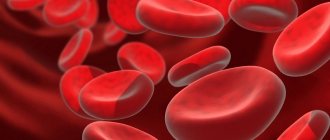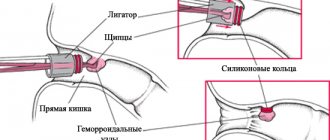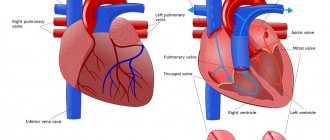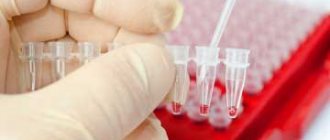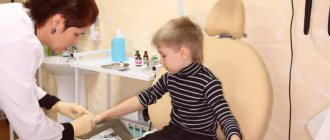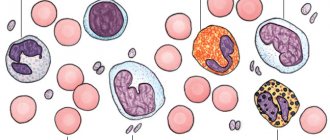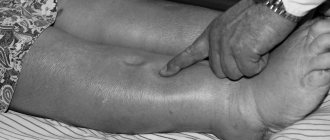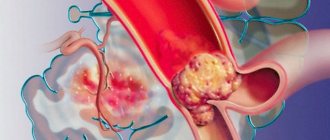Hemophilia - what is it, the cause and mechanism of development
Hemophilia is a blood clotting disorder that develops due to insufficient amounts of certain clotting factors in the blood plasma. In total, 12 coagulation factors are isolated, which are protein compounds and ferment a cascade of reactions that is triggered due to damage to the walls of blood vessels to prevent severe bleeding. As a result of such reactions, a blood clot is formed from fibrinogen protein filaments, it covers the damage, which leads to a gradual decrease in bleeding. Platelets also take part in this process; they have the ability to stick together and attach to the wall of the vessel in the area of damage. Platelets are responsible for stopping bleeding from small vessels. Hemophilia is based on insufficient levels of the protein coagulation factor VIII - antihemophilic globulin. The synthesis of this compound occurs in liver cells and is regulated by a gene that is localized on the sex X chromosome. A mutation in this gene determines the development of hemophilia and is inherited. Due to the fact that women have a sexual genotype of XX, and men have XY, only men suffer from hemophilia, since there is no such gene on the Y chromosome and the mutated gene on the X chromosome does not overlap.
In the past, hemophilia was more common among royal families (particularly in Europe), due to the high number of consanguineous marriages and the accumulation of mutated genes. They also developed other genetic diseases.
“They told my mother that I would only live until I was 18”: the story of a Yekaterinburg resident with hemophilia
When asked what you know about hemophilia, the most popular and, most likely, only answer will be that the heir to the imperial throne, Alexei Romanov, suffered from it.
According to information from the Sverdlovsk organization of the All-Russian Hemophilia Society, there are about 20 thousand people living with this disease in Russia, and almost 300 people in our region. One of them is the head of the organization, Rifat Zainutdinov. We met with him on the eve of World Hemophilia Day, which is celebrated on April 17.
“I was born with bruises on my body,” says Rifat Ravilievich. — Within a year or two, bleeding began and the hospital diagnosed him with hemophilia.
This is a rare hereditary disease associated with a blood clotting disorder. Hemorrhages occur in the joints, muscles and internal organs; they may be spontaneous or may be provoked by injury or surgery. Without the necessary treatment, a person can die from hemorrhage in the brain or other vital organs, even with a minor injury.
When Rifat was three years old, the family moved from the Perm village to Sverdlovsk. He was an active child, ran, played football and hockey, fought, went swimming and, as a result, was often hospitalized. The admonitions of my mother and doctors did not help.
“With hemophilia, a bruise can grow to enormous sizes, so I recently hit myself with a crutch, stumbled, my whole leg was swollen,” Rifat Ravilyevich shows his ankle. - When cuts occur, the blood stops for a very long time.
When we didn’t have the drug, the coagulation factor, blood could drip for a day, two, three. The pain was such that you were climbing the walls. When I was a child, I would run around, play enough football and hockey, and in the evening I would scream in pain.
Mom calls an ambulance.
Rifat was twice on the verge of life and death. The first time was after a fight (he was severely beaten), the second time was when he had an accident in 1993. On the highway, another car crashed into the car in which he was riding as a passenger.
With broken legs and severe bleeding, he was taken to Revda hospital. Friends, knowing that blood would be needed, surrounded the building and wanted to become donors.
The head doctor asked me to tell the guys to leave, times were difficult, the doctors were simply afraid of such a crowd at the hospital.
“I called my closest friend and said that everything was fine, let them go to Pervouralsk to the blood transfusion station or to Yekaterinburg. And with my childhood friend Rafail, we actually became brothers; he, like me, had the 4th positive blood group, and we had, one might say, a direct transfusion,” recalls Rifat Ravilyevich.
For four years after that accident he was in a wheelchair. Then he went to Moscow for an operation, and there he was raised to his feet, now Zainutdinov walks with the help of crutches, drives a car, and his first car after the operation was given to him by his friends.
“I have a friend, a businessman, he stirred up all my guys, saying that Rifat will sit at home, let’s raise money and buy him a car. And then somehow they arrive, shouting under the windows: “Come out!” I go out, there is a white car at the entrance, a table is set, a cut glass, keys in it. I drank a glass and just burst into tears. I wanted to cry because I had such friends. I was lucky with them.
Rifat Zainutdinov is 55 years old, he has a son and a daughter. In Soviet times, it was believed that he would not be able to live to that age:
“For our eighteenth birthday, all our friends and relatives gathered together. I remember my mother prepared a cake and began to cry. He says: “Son, they said that you would live to be 18 years old - 21 years old, but you have already turned 18. Then I became 21, 23, 25... Life goes on.
It continues largely thanks to the drug “Octanate” - this is a human blood clotting factor, which patients with hemophilia are administered when bleeding occurs. One package costs 5,500 rubles, Rifat needs 40 per month. But, fortunately, hemophilia patients receive Octanate for free.
“In 1999, we operated on a young man, he did not say that he had hemophilia,” says Rifat Zainutdinov. “Our mobile hemostasiology team calls, they say we can’t stop the bleeding, he will die.
I am calling the President of the All-Russian Hemophilia Society, Yuri Zhulev, in Moscow. I say: “Help us, we don’t have a factor.” They sent him by plane within 24 hours, and the guy was saved. Then again some incident happened, and Yura said to me: “Maybe you’ll start hammering your authorities?”
Then I went to Semyon Isaakovich Spektor, I am very grateful to him, he is the first person in the government who supported me and knocked out 2 million so that we would have reserves of Octanate.
Then the deputies helped to include another 15 million in a separate line for the purchase of the factor, the City Health Department gave half a million so that the mobile team would always have this drug.
He began working on the problems of hemophilia patients in the Sverdlovsk region in 1998, heading the regional organization of the All-Russian Hemophilia Society. The first step was to organize donor events, attract private security companies, bus drivers, talk about donation on television, calling for blood donation not only for hemophilia patients, but for everyone who needs it.
“I’m a Tatar, and mostly Tatars and Bashkirs helped me,” says Zainutdinov. — Thanks to all my acquaintances, friends who supported and helped.
Hemophilia, contrary to popular belief, does not only affect men. Women get sick very rarely, but such cases still exist, and in Yekaterinburg too. Plus, women have von Willebrand disease, also a hereditary blood disease that causes spontaneous bleeding, similar to bleeding in hemophilia. One day, Rifat met a woman with hemophilia by chance in a taxi.
— I have an order, a woman sits down with two children, we got to talking, it turned out she has hemophilia. He says, so you’re the president of our society and you’re a taxi driver? Well, life forces you. You, he says, saved my life. Tells. She began bleeding during childbirth, and at that time, in 2006, for some reason we did not have a factor in the city. I didn’t know what to do, I went to Zhenya Roizman, he was then a State Duma deputy, and told me what and how. The next day we are sitting in the organization’s office, bang - the prosecutor’s office comes. I overheated, I think I did something wrong, I think I’m watching my language,” Rifat Ravilievich laughs. — They say: we received a complaint from State Duma deputy Roizman. And within 24 hours we had a factor. The woman's bleeding was stopped. I was pleased to hear this story. Now Alexander Bessmertnykh is helping Zainutdinov with the organization; he also has hemophilia. The diagnosis was made at three years after examination due to frequent hematomas and bleeding. They immediately checked my younger brother - he also has hemophilia. Both Rifat and Alexander had the first cases of the disease in the family. Two months ago, Alexander underwent knee replacement surgery - this is also a consequence of the disease.
“Our main task is to maintain Octanate dosages so that everyone has enough doses to live without bleeding,” says Alexander. — There are such problems that the ministry wins back the tender, but they have not yet had time to deliver the drug, there are delays from two weeks to a month. We're looking to see who has saved supplies that can be given to people who need it right now.
“We hold meetings in the ministry, in the city health department, we solve pressing problems with donation,” adds Rifat Zainutdinov. — I like that young guys have become very active, there is such Timofey Zhukov, he has been helping us for the second year with the logo of the All-Russian Hemophilia Society, this logo will be lit on the evening of April 17 at the Yeltsin Center. And we are very lucky that we have a visiting team; it is the only one left in Russia.
Previously, there were such teams in Moscow, St. Petersburg, Kirov, but they were gradually abandoned, and patients call a regular ambulance. A leading specialist in hemophilia and von Willebrand disease in the Sverdlovsk region, Farida Perina, believes that this is correct.
“As a doctor, I don’t really support the presence of a specialized team,” she told E1.RU.
- Yes, of course, this is a rescue team, but if the patient gets used to the fact that there is a team, he will not help himself on his own, and this is scary.
All over the world, therefore, it seems that specialized teams are being abandoned; there should just be an ambulance that will provide assistance or take you to a medical facility. It is necessary that every patient with hemophilia knows how to inject himself.
The organization conducts schools and seminars for hemophilia patients. This Saturday, a visiting nurse will teach them how to administer intravenous injections on their own.
“I always drive a factor in the car,” says Alexander Bessmertnykh. “Once, while on vacation outside the city, a stick flew off into my knee, and it began to swell.
When bleeding occurs, the blood spills out, pinches the blood vessels, the joints expand, resulting in pain. It gets to the point where the knee swells up like a two-liter can. And there is nowhere for the blood to go, there is no outflow.
In another situation, I had to look for someone to take me to the city, to the hospital. But I had a factor, I gave myself the injection.
Rifat Ravilievich also learned to give intravenous injections himself. He shows his hands - they are all in “paths”. A comparison inevitably arises.
“There were such incidents,” he nods. “It happened that we were mistaken for drug addicts, they locked us up in the police station, and a team came out and pulled us out. After one such incident, I thought, let me write a letter to the police, they responded, and I came, spoke, explained what hemophilia is.
Zainutdinov teaches parents who have children with hemophilia not to overprotect them and not to lock them at home (some transfer their children to home schooling).
- If a person moves only around the apartment, almost never goes outside, he, on the contrary, will have more hematomas. In addition, a person somehow withdraws, sits on the computer, and doesn’t need anything else. But you need communication, friends, and, after all, going on dates. There is no need to prohibit anything.
If a bruise appears, if it doesn’t hurt, let it dissolve; if it hurts, give it a factor, and let the child run and jump further. We had a hockey player with a mild form of hemophilia, a master of sports in arm wrestling.
This is what I constantly try to instill in parents: “Don’t be afraid, let the child grow, let him move, so that the joints, arms and legs bend and develop.”
The carriers of the disease are women; the carrier has a 50/50 chance of giving birth to a sick child. According to Farida Perina, children with hemophilia in the Sverdlovsk region have become less frequently born.
Future parents undergo prenatal diagnosis and, if this is not the first child and hemophilia is confirmed, they are ready to terminate the pregnancy.
But there are two families who refused diagnosis and are now raising three children with severe hemophilia.
“This is also a good symptom, actually,” says the specialist. — That is, psychotherapy has been carried out, people understand that they live happily ever after with hemophilia, the main thing is to inject the factor in a timely manner.
Moreover, we teach patients to do this, we explain that it is necessary to carry out prevention. There are very smart patients in our region, I love and respect them. Every summer since 1995, our hemophiliac group goes on vacation to the sea.
All our patients are like one big family.
Patients with hemophilia are in vital need of donated blood. We talked in detail about how to become a donor in Yekaterinburg. You can also read real stories about how the people of the Urals were saved by donor blood.
Source: https://woman.rambler.ru/other/42047971-mame-govorili-chto-ya-dozhivu-tolko-do-18-let-istoriya-ekaterinburzhtsa-s-gemofiliey/
Manifestations
Hemophilia in children is manifested by the development of bleeding of various localizations, most often it develops from the vessels of the joints, which leads to the accumulation of blood in their cavity - hemarthrosis. Hemarthrosis is accompanied by severe pain, redness of the skin over the joint, and it is hot to the touch. There is also a decrease in the volume and range of motion in the joint. Repeated hemarthrosis gradually leads to the destruction of cartilage and the development of deforming osteoarthritis, which may already appear in adolescence. There may also be hemorrhages in the internal organs, subcutaneous tissue and skin (bruises). Various minor injuries - bruises, blows - provoke bleeding. This is of particular relevance since children are very mobile and are more susceptible to minor injuries.
If a child is diagnosed with hemophilia, it is necessary to try to limit him as much as possible from possible injuries. There have been cases of death from massive internal bleeding due to even minor trauma.
The severity of hemophilia is determined by the degree of factor VIII deficiency; depending on this, there are 4 degrees of severity of the blood clotting disorder:
- Latent degree - the level of antihemophilic globulin is more than 10%. At the same time, hemophilia does not manifest itself clinically; it can only be determined using laboratory tests (hemogram).
- Mild degree - level 5-10%, is characterized by the frequent development of hemarthrosis after a bruise or blow to the joint area.
- Moderate degree - level 1-5%, there is a risk of massive bleeding even with minor impacts on the body (vibration, shaking).
- Severe degree - a level below 1%, this degree of coagulation disorder can lead to severe bleeding even at rest, and therefore requires intensive treatment in a hospital setting and constant medical supervision.
The first manifestations of hemophilia in children can be no earlier than six months or a year, since, subject to breastfeeding, the deficiency of blood coagulation factor VIII is partially compensated by mother's milk.
Signs of hemophilia in children
In children suffering from hemophilia in the first year of life, bleeding occurs during teething. But often this disease manifests itself after the child begins to walk, as movement leads to activity and the risk of injury increases. Hemorrhages tend to spread; hematomas are common, the resorption of which is quite slow. The blood remains liquid for a long time, as a result of which it penetrates into the tissues. Hematomas can be such that their presence contributes to compression of large arteries or peripheral nerve trunks, causing gangrene and paralysis.
Hemophilia is characterized by prolonged bleeding from the gums, mouth, nose, and in rare cases from the kidneys and gastrointestinal tract. Intramuscular injections and various operations can lead to more severe bleeding. The most dangerous bleedings are considered to be laryngeal ones, as they contribute to the occurrence of respiratory obstruction. Hemorrhages in the brain are also possible, and this leads to severe damage to the central nervous system. The obvious symptoms of this disease are bleeding in the joints, which is accompanied by characteristic pain.
The probability of giving birth to a child suffering from hemophilia is as follows: if a mother has a son who has this disease, then her grandson will be 100% sick. If a granddaughter is born, she will be a carrier of the gene. There is a 50% chance that the girl will be healthy.
Consequences of hemophilia
All complications and consequences of this pathology are associated with the periodic occurrence of bleeding, these include:
- Death is the most serious consequence associated with intense bleeding from a large vessel that could not be stopped in time. This consequence can be caused by injury. In this case, internal bleeding is more dangerous due to the difficulty of determining its location and stopping it in a timely manner.
- Development of anemia (anemia) associated with blood loss.
- Immunodeficiency is insufficient functional activity of the immune system as a result of loss of leukocytes during bleeding.
- Deforming osteoarthritis is the gradual destruction of joint cartilage, its inflammation due to repeated hemarthrosis.
The most basic goal of treatment and prevention of hemophilia is to prevent the development of consequences.
Treatment
Without targeted therapy, the likelihood of death is high. Treatment for hemophilia involves replacement therapy and infusion of the missing clotting factor into the bloodstream. The dose is selected individually. In case of bleeding and a high risk of its occurrence, the patient requires:
- complete bed rest;
- taking hemostatics and angioprotectors;
- administration of plasma and prothrombin complex.
Patients should carry a special document with them, which should indicate the type of pathology, Rh factor, blood type and principles of treatment. Hemophilia in women may require support during menstruation. The rest of the time, the pathology is often not life-threatening for the patient.
Treatment of hemophilia
Treatment of this pathology is complex; it has several areas, which include:
- Replenishment of factor VIII - for this purpose, an intravenous infusion of a blood product is performed - cryoprecipitate, which contains a significant amount of antihemophilic globulin and fibrinogen (a fibrin precursor protein, which is the basis of a blood clot). This treatment makes it possible to convert hemophilia into a latent form. This treatment method is the only method that can effectively combat bleeding in hemophilia in children.
- To combat the consequences, this involves transfusion of red blood cells and the use of iron-containing drugs for anemia, taking immunomodulators to restore the functional activity of the immune system and chondroprotectors, which help restore damaged joint cartilage.
- Emergency stop of bleeding - various manipulations are carried out, depending on the location of the bleeding, from applying a tourniquet to a limb to performing urgent surgery for internal bleeding. Also in this case, an infusion of fresh plasma is carried out, which contains all the necessary coagulation components.
Today, drugs are being developed that contain ready-made antihemophilic globulin obtained through genetic engineering (on the same principle as modern insulin, which is produced by yeast-like fungi after implantation of the gene responsible for the synthesis of this hormone).
It should be remembered that hemophilia is not a death sentence for a child. With the disciplined implementation of medical recommendations, the child grows and develops harmoniously, without any changes in other organs and systems. It is important to avoid traumatic bleeding.
Symptoms of hemophilia
The first and main sign of the disease is bleeding, which can be observed in different age groups. The following symptoms are also characteristic of this disease:
- recurrent nosebleeds;
- detection of blood elements in urine and feces;
- extensive hematomas formed after minor injuries;
- continuous bleeding resulting from tooth extraction or injury;
- Hemarthrosis (intra-articular bleeding) causes blood to flow into the joints, causing limited mobility and swelling.
Symptoms of the disease in childhood
Severe hemophilia develops in children during the first year of their life. Symptoms characteristic of it are the following:
- bloody discharge from the umbilical wound;
- hematomas, which, initially having a point nature, spread to different parts of the body and are localized both subcutaneously and on the mucous membranes;
- bleeding that occurs after preventive vaccinations and other injections.
In addition to the above signs of the disease, in children starting from 2-3 years of age, symptoms such as articular ones, as well as small capillary hemorrhages (petechiae), which form for no reason during slight physical exertion, can be observed. Hemophilia in children from 4 years of age to school age is often presented by:
- recurrent nosebleeds;
- discharge from the gums;
- periodic presence of blood in the urine (hematuria), the level of which is above the normal threshold;
- extensive bruises (hemarthrosis), the development and long course of which contributes to the appearance of chronic contractures, arthropathy, as well as synovitis;
- detection of blood elements in the child’s stool, indicating the initial stage of progressive anemia;
- progression of bleeding localized in internal organs;
- possible hemorrhages inside the brain, threatening severe damage to the central nervous system. Children with this complication are characterized by decreased appetite, thin physique and lack of discipline.
Symptoms of hemophilia in children
Such children may develop mild but prolonged bleeding that occurs after intramuscular injections. Therefore, they are recommended to be vaccinated and administered medications subcutaneously using a thin needle.
The danger of the disease, in addition to impaired hemostasis, consists of possible complications:
- leukopenia;
- hemolytic anemia;
- disabling renal failure;
- thrombocytopenia.
Due to the low immune response of the body that developed as a result of this disease, children with hemophilia often develop various types of complications with age.
Symptoms of the disease in women
Although the incidence of hemophilia in girls and women is extremely low, it is not completely excluded. Its course is mild, and the most common symptoms of the disease are as follows:
- heavy menstrual flow;
- bleeding that occurs after removal of tonsils or teeth;
- nosebleeds;
- von Willebrand disease, causing causeless episodic bleeding.
Symptoms of the disease in men
Hemophilia under a microscope
In adulthood, the disease only progresses. In addition to the signs of the disease already present since childhood, new symptoms are added to it, causing much more harm to the body:
- retroperitoneal bleeding. Their development provokes the appearance of acute diseases of the peritoneal organs, which can only be resolved surgically;
- the formation of bruises, indicating both subcutaneous and intramuscular hemorrhages. Their danger lies in the compression of the vessels feeding the tissue, which leads to tissue necrosis. There is also a risk of blood poisoning due to infection;
- posthemorrhagic anemia caused by nasal, gastrointestinal bleeding, bleeding from the gums, as well as the urinary canals;
- hemorrhages in bone tissue, leading to its necrosis;
- gangrene and possible paralysis resulting from giant hematomas;
- bleeding of the mucous lining of the throat and larynx. May occur when the vocal cords are tense, as well as coughing;
- joint hemorrhages contribute to the progression of osteoarthritis, ultimately leading to disability. The reason for this is limited joint mobility and atrophy of the muscles of the limbs.
To perform surgery, such patients are pre-administered antihemophilic drugs to avoid large blood loss.
How to diagnose and treat hemophilia?
To make a diagnosis, it is necessary to perform a genealogical history, undergo laboratory tests and study the clinical picture of the disease. The doctor must find out whether the patient’s close relatives, in particular men on the maternal side, suffered from hemophilia.
During a laboratory blood test, a plasma sample is added to it, in which there is no clotting factor. It is important to determine the total amount of these factors, as well as the level of their deficiency, and conduct an analysis to clarify the blood clotting time. The results obtained will allow us to evaluate the changes that occur in the patient’s body.
Although the disease cannot be cured, its course can be controlled. Patients will need to receive injections of the factor that is deficient in the body. So, with hemophilia type A, a person receives factor VII, and with hemophilia type B, a person receives factor IX. These factors are produced either from donor blood or from the blood of animals that are raised specifically for this purpose.
If a person is careful about his own health, and the doctor prescribes him the right treatment, then his life expectancy can be equated to the life expectancy of an ordinary person.
Exercises for rehabilitation and development of joints in hemophilia:
Vaccinations and hemophilia
A vaccine for the disease has not been developed. Some people confuse the Haemophilus influenzae vaccine with the hemophilia vaccine. However, these are two completely different diseases.
As for routine vaccination, for hemophilia it should be carried out as expected. However, injections must be given subcutaneously and not intramuscularly. The fact is that intramuscular injections are associated with the risk of a large hematoma.
Scientific interpretation of the concept
The disease is associated with a gene that is linked to the X chromosome. Hemophilia develops extremely rarely in women, since they have two X chromosomes , one of which is intact.
Males have one Y chromosome and one X chromosome. In this case, the disease will definitely manifest itself.
In order for a sick female child to be born, a sick father and a carrier mother are needed. The likelihood of such a coincidence in nature is extremely low.
There are three types of the disease, two of which are distinguished by chromosomal mutations - the A and B varieties. The third type is excluded from the classification because the symptoms of hemophilia C differ from the previous two. The third type of disease does not cause increased bleeding and is less dangerous. It is discovered randomly when blood clotting tests are done. There is usually no treatment.
Type A
The most common classical type of hemophilia is A, which accounts for about 80% of patients. It is caused by insufficient presence of clotting factor VIII in the blood. There are 13 of them in total. The lack of at least one creates problems in the process of blood clotting.
The disease manifests itself severely:
- bleeding begins with bruises or falls;
- during surgical interventions;
- there is a high probability of internal bleeding in the organs, which can lead to premature death if the missing blood component is not administered in time.
Large vessels are most often damaged, and large subcutaneous and intramuscular hematomas occur.
Bleeding in the joints is a common occurrence in hemophilia. The joint increases in size, the temperature rises, and the limb loses mobility .
The accumulation of blood in the joint causes a lack of oxygen in the tissues, and the development of infectious arthritis is possible.
The consequence of frequent arthrosis in hemophilia is disability:
- paresis – pathology of nerve tissue;
- paralysis - muscle failure due to the death of nerves;
- damage to the joint - cartilage and bone tissue.
Treatment consists of timely administration of drugs:
- cryoprecipitate - protein components of blood that enhance coagulation;
- fresh frozen plasma intravenously;
- prothrombin complex - a set of clotting factors that is administered before surgery to reduce blood loss.
These drugs are used in several ways: immediately after a bruise and bleeding has begun, and regularly in small doses to prevent hemorrhages. In Russia, the situation with drugs for hemophilia is complex: the drugs are expensive, it is difficult to get them, so most often stocks are kept in case of an unforeseen situation. In the West, there is a different technique: they begin to administer medications regularly from childhood, so the child does not even suspect that he has a tendency to bleed.
Important!
Children are recommended to carry with them records of their blood type and Rh factor - a hemophiliac passport, so that at any time they can provide the necessary assistance and undergo a blood transfusion.
Type B
In type B hemophilia, the formation of a secondary coagulation plug is impaired. Factor IX deficiency is also called Christmas factor deficiency. The mutated gene is also linked to the X chromosome, so men are more prone to the disease.
Blood loss can be controlled by administering plasma protein intravenously.
Important!
Patients are prohibited from intramuscular injections, as there is a risk of bleeding due to vascular damage. Operations are performed only for vital indications and with the use of clotting factors.
Type C
The most rare. It occurs with equal frequency in both men and women. The disease is caused by a deficiency of blood clotting factor XI.
Extensive bleeding is not observed, the disease manifests itself unstable: patients with a large deficiency of plasma components do not have a tendency to hemorrhage, and with a moderate deficiency they may be at risk during surgical operations, after injuries or severe bruises.
Type C is more difficult to diagnose, since there are no obvious symptoms until a certain point. The disease may appear at an older age.
